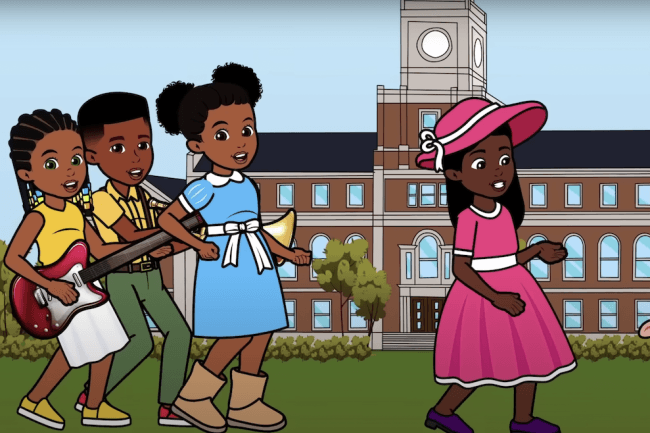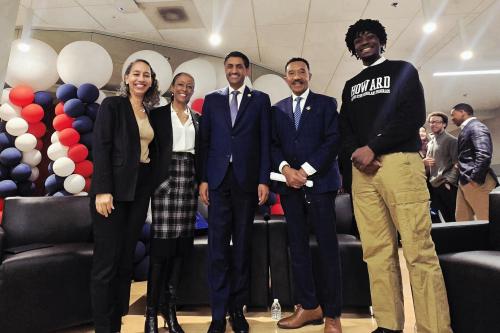Symone Campbell: How would you describe your digital footprint?
Javoris Hollingsworth: I would describe it as just creating fun educational videos where the whole family can really just enjoy it all together. Yeah, I think that’s how I would describe it.
Arlene Hollingsworth: And the videos and the content we make focus on having children of color in the forefront and also there’s a heavy emphasis on music.
SC: What challenges, if any, have you faced as a Black family in tech? And how have you addressed critiques of your content?
JH: To me, the greatest challenges [is], it is crazy how fast technology continues to evolve and change. Of course now one of the biggest things is AI and all these other new technologies that are constantly being developed, but that’s probably been the biggest thing, just trying to make sure that we’re staying up to date with what’s hot and what’s relevant and what’s important because it’s so easy to get left behind. So I think that’s probably been the biggest challenge.
AH: So I think that’s just part of what we have come to expect, and anyone that’s doing anything can expect, at least in this area, when we talk about technology, entertainment, the critiques come with it. And I think it depends. Sometimes there’s feedback we will get that’s constructive and we’re always listening to that and that’s always helpful. That’s how you get better. But then there’s some criticism we get, it’s not helpful. And so that may be something we just learn how to block out.
Amy Yeboah Quarkume: What would you describe what you’ve created?
JH: I think definitely with the tech, the music and just the representation honestly too. And that’s something that I think that has really made what we’ve done so special, because when you look at what’s available out there, especially in edu-tainment, there’s just a great disparity, especially when we’re talking about children of color being in the forefront.
SC: Have you thought about addressing issues of digital access for black kids in areas where access to the internet is limited for them to be able to access your content?
AH: Definitely. So that’s something that we are thinking about all the time because the goal is to make sure that the content we make is accessible to anyone. And so a goal would be to get on to a network that broadcasts locally for those who aren’t able to afford subscriptions. Another goal would be to put content on DVDs, although DVDs still have a cost, it may be something that allows it to be more accessible to those who maybe don’t have the means to pay for a monthly subscription. But definitely a big thing we’re thinking about is getting on local networks.
SC: How do you manage protecting your image as a Black family when AI and technology in general doesn’t protect Black women, girls, and families?
AH: I think one of our things that we do is try our best to always be intentional and mindful of the images we’re putting out. That’s an important thing. I think the thing that is important to note is regardless of how hard you work, it may be really impossible to 100% protect yourself from all of that. But we try our best of course to monitor if anyone’s doing anything that looks like it is copying us substantially. And then like I said, we’re just always mindful of the images we put out. We’re very intentional.
JH: Yeah, what I was going to say to that too is that, and it was so interesting because I saw something recently with Lil Wayne, someone presented a similar situation to him and he was like, oh yeah, I’m not worried about AI. You can’t duplicate this. Or it was something along those lines of basically him saying how unique of what he does and what he brings. But I feel like with our content, it really does come from a special place where we try to capture and represent the Black community honestly. And I feel like we see ways where AI or even people try to do their rendition or version of it, but I don’t know, I feel like the Black community itself we’re really good at detecting something that’s just not authentic. But yeah, like my wife said, it is really hard considering how advanced a lot of technology is. But right now though, I really think that we really are doing something that is just unique and special in its own right.
SC: We wanted to hear from Gracyn also. What future goals do you have for Gracie’s Corner to have a lasting legacy? How does it feel to see how much your character impacts Black children around the world?
Gracyn “Gracie” Hollingsworth: I’d say that our main goal is to make sure that kids have fun watching and getting to see how much impact it’ll be forever. And then for the other question, I’d say that it’s really exciting and amazing to see kids getting all excited and jumping up, watching our videos and they look so happy and it’s just so happy to see them being so happy watching videos.
AH: Yeah, I mean with regards to what we’d like to see, a big goal is for this to become a global brand. And you kind of touched on this, a goal is for it to be accessible to everyone, for it to be something that has a lasting impact. So from products to music on the radio to tours, you name it because it’s important. There’s so many things that we intentionally do and we want to make sure that it’s not only helping our children but our children’s children.
SC: Gracie’s Corner has Black children viewers around the world, have you thought about translating this into African Languages and also how far is your global reach?
JH: Yeah, that’s a great question and that’s something that we’ve been working on right now as far as the localization of our content because right now it is primarily English. We start to make some traction as far as translation to Spanish. But to your point though, I think as things continue to develop, we’re just trying to continue to offer our content in additional languages.
It would be great to have it in Swahili, have it in [any language] you name it, just across the board because the message that we’re sending is something that I feel all children should hear ranging from learning to love your hair, learning to take deep breaths when you’re in distress, learning that you’re special, learning all these things that are valuable, but again, that language barrier is a big piece. So trying to get over that hump, that’s definitely what we’re working on now.
SC: What has been your most memorable customer feedback?
AH: So we definitely love to look at comments that are left on social media. We also have had families that have walked up to us. I would say our most memorable feedback has come from families. I know we’ve had a couple families that have told us that they have children that are limited verbally or nonverbal, that have a diagnosis of autism spectrum disorder, and that our videos have helped them learn words. That’s been awesome to hear that. And then we’ve also had families tell us the excitement of being able to see their children, see characters that look just like them. And so that’s been the great feedback, that is why we keep doing what we do.
SC: I see so many videos of Black kids and even Black kids with autism dancing to Gracie’s Corner, just vibing with the music and it sometimes brings tears to my eyes. How does that make you feel?
JH: Honestly to this day it still blows my mind whenever I see that same type of content too. Because it’s like we set out to try to help improve or provide content that our kids can relate to and can see themselves in. But to see how it’s reached so many people and then the impact is just unreal to me. Those moments where I’m watching a grandma with her grandkids or with the kids rowing the boat or doing anything like that, or when I see little kids who are probably less than one year old that’s making letters sounds or the one that blew my mind the most was like I saw a baby that said, ‘Q is for quintessential.’ And I was like, whoa! So those moments are really amazing and special and to know that we’re contributing to that development and that empowerment is just unreal.
SC: Is there any future plans to feature HBCUs, particularly Howard, on Gracie’s Corner?
JH: Yeah, we’ve been tossing that idea around. So we’ve done it in a very subtle way. So we did it with Mary Had a Little Lamb. The whole idea for it was that the song was really built on go-go music. So we gave a shout out to Chuck Brown, one of the fathers of go-go music. But yeah, if you look at it, there’s little glimpses of the Howard campus, but again, it is very subtle. So we haven’t done anything that just full blown features an HBCU, but that definitely is an idea.
AH: Yeah, we’d love to. I think it’s just a discussion. And I think the issue is there’s so many wonderful HBCUs. I worked at one, I worked at Texas Southern University, and he worked at FAMU. It’s one of those things where I think our biggest fear is leaving one out and then feeling that we don’t love all of them. That’s probably why it’s like, man, you only have three minutes and there’s so many. But I definitely think our way of showing different campuses is something I’d love to do. We would love to definitely talk to some of these universities. I know there’s licensing and stuff involved, but that’s definitely a discussion. Those are definitely discussions we’d love to have.





